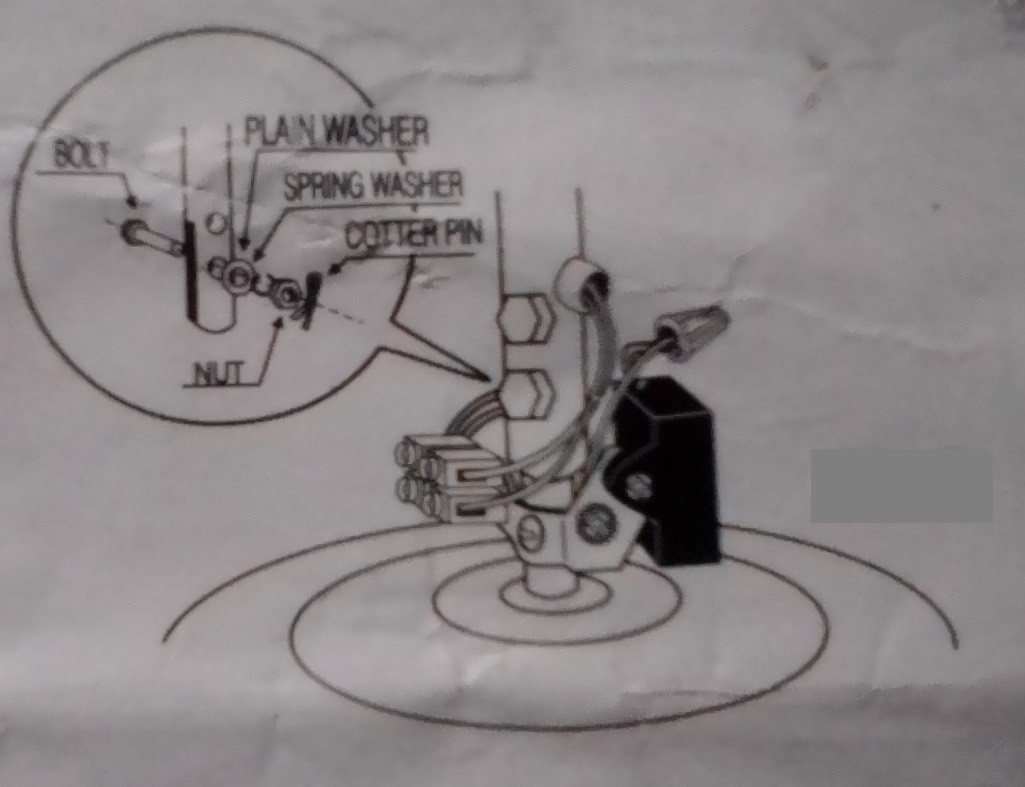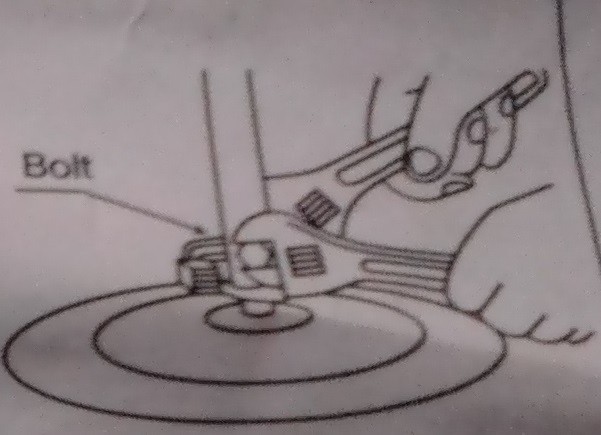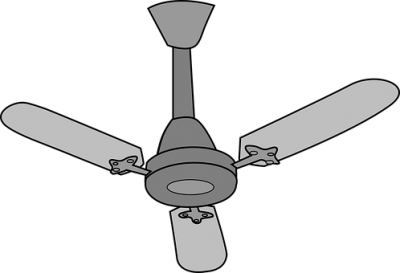INSTALLATION GUIDELINES FOR CEILING FAN
Here are simple steps you can use to install your new ceiling fan without any electrician experience.
The ceiling fan comes in various sizes and brands, all of them have a similar appearance but may vary in design. It is important to know that the procedure that will be discussed in this post will enable you to install any design or brand of a ceiling fan.
For educational purposes, a ceiling fan is an electric fan with wide blades usually three or four blades. The electric fan has its engine of the electric motor at the center, the engine has an outlet shaft that connects to the steel hose that links the fan to the hook nailed on the ceiling.
The picture below illustrates the diagram of a ceiling fan:

From the Diagram, the following is worth taking note of because they will be used to explain the installation procedures;
SHACKLE: the shackle is a rubber or tire material that forms a roller shape having a hole at the center where a big bolt (with or without a screw) passes to form a link between the two steel plates at both sides of the download and the Rubber material.
The Rubber roller or material has hollow space around its center of circumference where the hook from the ceiling passes. The whole set-up that assists the upper end of the Downrod to join with the Hook at the Ceiling is known as the Shackle.
UPPER CANOPY: the upper canopy is located just below the shackle. It is a plastic cup shape having a hole at the center for the Downrod to pass through it. The shape of the upper canopy varies according to fan brand and size, however, they all perform the same function.
The upper canopy hides the shackle connection to the Downrod and the cable connection that passed through the hollow hole of the Downrod. In terms of size, it is usually bigger than the Lower Canopy which shall be discussed next. The upper canopy has a screw at the down edge which will be used to tighten it to the Downrod after pushing it to the top.
LOWER CANOPY: the lower canopy has a similar appearance to the upper canopy and can possibly mistakenly be interchanged, though interchanging them may not have an impact on the functionalities of the ceiling Fan, physical appearance of the Ceiling Fan after installation may look odd.
The lower canopy hides the connection between the Downrod and the engine shaft. The connection will be illustrated later. Besides the connection, it also hides the cable wires that supply current to the engine (Electric motor).

DOWNROD: the Downrod as illustrated in the diagram is about 1 foot in length steel pipe approximately 20mm in diameter. It can be shortened by cutting it with a hacksaw and manually creating a new hole at both sides of the one end that has been cut.
The condition that will be required cutting the Downrod is the case that the ceiling is too low such that the fan if hung with the Downrod may possibly be hitting people in any small attempt to raise a hand or hang something on the building wall.
Shortening the Downrod simply makes the ceiling fan to be closer to the ceiling and reduces the tendency of hitting people while rotating. However, for ceilings up to 10 feet height there would not be a need to cut the Downrod.
The Downrod has two holes at both ends located opposite each other such that a single bolt can pass through them. The holes located at the upward end carry the bolt that anchors the Rubber roller-shape material whose function is to carry the Hook nailed to the Ceiling.
While the downward end holes carry the bolt that anchors the electric motor shaft with the Downrod. In other words, Downrod acts as an extension of the electric motor shaft and it hides the cable wires that supply current to the electric motor because the wires usually pass through the hollow hole of the pipe.

BLADES: the blades of the ceiling fan are usually three but can as well be four. The blades are evenly-spaced to maintain equilibrium. The blades have two holes at the edge that enables screws to anchor them at the top of the electric motor engine as illustrated in the diagram,.
If properly installed ceiling fan blades form an angle of inclination from the normal level of the fan engine. About 15-degree angle of inclination on each blade towards the clockwise direction that each blade will rotate.
The blade inclination is to enable the blades to force or push down a large volume of air during rotations.
CEILING FAN REGULATOR: the ceiling fan regulator is the unit that controls the ceiling fan. It switches the ceiling ON r OFF, it has speed selectors that could range from 1 to 5 depending on the brand. The regulator is not attached to the ceiling like the case of other electric Fans. Rather, it is usually hung on the wall close to the doors of the entrance.
CEILING FAN INSTALLATION PROCEDURES
- Pass the electric Cord and wire through the pipe and insert the cord spring.
- Place the cap on the motor shaft. Subsequently, insert the pipe into the motor shaft and secure it in place using the bolt, one plain washer, one spring washer, and one nut. Insert the cotter pin and bend it.
- Firmly tighten the bolt and nut by using a wrench as illustrated in the diagram. Tightening torque 100N-cm or more. Insufficient tightening will result in abnormal noise, vibration, or shortening of product life.
- Mount the hanger hook with the bar hanging assembly with screws independent of an outlet box into the building structure.
- The electrical supply must incorporate a double pole switch with a contact opening of at least 3mm.
- Do not install paddle fan less than 2.3m between floor and lowest edge of the fan blades.
- After installation checks the instructions listed to ensure the accuracy of the installation before connecting to the electrical supply.
- If the ceiling fan fails to produce airflow while rotating, then you have probably set the blades wrongly or the Ceiling fan may be rotating anti-clockwise against the blades settings.
HOW TO INSTALL THE SPEED REGULATOR
- Unscrew the regulator cap
- Connect wires through the inlet hole according to the diagrams
- Mount the regulator on the wall on a wooden base nailed to the building wall.
- Take a closer look to ensure all wire connections are done properly.
SAFETY PRECAUTIONS
Before hanging the ceiling fan, ensure that the Ceiling fan hook fixed on the Ceiling is firmly nailed to the major wood used in the Ceiling wood skeleton.
If you are not sure of the strength of the hook to carry the weight of the Fan and to withstand the vibrations and stress that comes from the fan during speedy rotation, then it will be unsafe to hang the fan on such a hook.
Instead, call a carpenter or a technician to fix the hook inappropriate location.
If you have no knowledge of electric wiring, then do not attempt to fix the cable wires yourself rather allow electricians to do that for you.
The ceiling fan should not be close to the doors but rather should be located at the center of the room where it has enough space from anything that could possibly touch it during rotation.
According to most manufacturers’ standards, at least 3 feet of space from the end of each blade should be given to avoid touching or dragging any object during rotation.
Install the ceiling fan at a height not less than 10 feet above ground level. In other words, the gap between the floor and the fan blades should be up to 10 feet high.
While testing the fan or even after the installation during its normal operation, never attempt to stop the fan by holding it on the rotating blade or trying to obstruct it with any object example log of wood or iron. The force from the blades can cause severe injury if obstructed.
